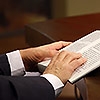A Messenger Between Two Poles
 Question: Why during reading The Book of Zohar do we not only have to focus on our mutual connection but also need to listen to the commentaries on The Zohar?
Question: Why during reading The Book of Zohar do we not only have to focus on our mutual connection but also need to listen to the commentaries on The Zohar?
Answer: First of all, if we read the original text of The Zohar, we have virtually nothing to go by. Therefore, we need the commentaries. A commentary is a connecting, somewhat-abridged authentic source either in the outer form, in the degree, or in several criteria at the same time. But it connects us to the original.
The Zohar per se is also a commentary on the Torah. The major part of The Zohar is based on citations taken from the Torah, which it processes in a different form. Does The Zohar comment on these passages at a level lower than that which the Torah was written by Moses or not? I don’t want to discuss it, but such question does arise.
Does the Sulam commentary reduce the degree of The Book of Zohar by making it closer to our understanding? We understand little of this. The following could be said: Each commentary includes two extreme points. At its highest point, the authors of The Zohar share Moses’ revelation at his level; otherwise, they wouldn’t be able to make the commentary.
But they write the commentary itself with the reader in mind, meaning in a simplified form and at a lower degree of the spiritual ladder. After all, the entire benefit from revealing the Torah lies in using it to correct the will to enjoy, as described by the verse: “I created the evil inclination, and I created the Torah for its correction.”
Hence, the author of a commentary has to stand on both levels: at the degree where he is receiving the source and at a lower degree to which he wishes to pass this source but in a more suitable form, adjusted to the receiver’s degree. This is the goal of each commentary.
Therefore, up to now, nothing can replace the Sulam commentary since on one hand, Baal HaSulam attained the degree of the ARI having thereby received the incarnation of the ARI’s soul and having attained the degree of The Zohar’s writers. On the other hand, he approximated The Zohar to our degree, explaining it in the three lines, in the language of Kabbalah, using the definitions of Partzufim, the worlds, Sefirot, Reshimot, and so on.
We don’t need anything else but to try to actualize it on ourselves. However, now the whole world is supposed to be approaching the transformation of souls. Hence, to make The Zohar easier to understand for the masses, we have somewhat refined The Zohar’s text from numerous symbols that might be an obstacle for a layman, in order to make the reading itself easier for him.
But we never add any comments of our own and only facilitate the mechanical reading of the text to help a person understand the text. We simply put it through some kind of “filter” that extracts all Aramaic language from it as well as some references and various versions. This is, in essence, what we did with the book The Zohar for All. Let’s hope that in this form, The Zohar is even more ready to use for the correction of the souls.
[32629]
From the 2nd part of the Daily Kabbalah Lesson 1/12/11, “Introduction of The Book of Zohar,” Article “The Donkey Driver”
Related Material:
The “Litmus Paper” Of Spirituality
Love Over Hate
A Step Between The Worlds

 Laitman.com Comments RSS Feed
Laitman.com Comments RSS Feed





I think that the three lines are an approximation. The middle is simply an example of the intention to bestow, to make peace and unite the broken parts (left and right in the middle upper third, which is MAN, its the male symbol, the maker). In reality, it is an infinitely detailed spectrum ranging between the two poles, the two points from which there is no perception beyond it because of lack of sensitivity, despite the fact that their light and darkness has no end. Every time two opposites are linked, they make a small twig, a piece of the tree. Once enough links at a given level are made, the upper third of the previous level can become the left or right of the higher one. Imagine a tree structure, that is exactly how it is. Once enough unions and levels have been passed, a person reassembles a unified psyche and senses with their entire being, the true and infinite reality. It is a source like a river, flowing without end, always there, even now, even here.